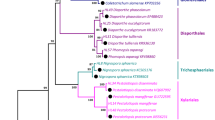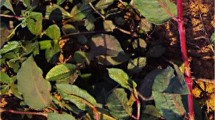Abstract
The Antarctic endophytic fungus (strain ITA1-CCMA 952) was isolated from the moss Schistidium antarctici found in Admiralty Bay, King George Island, Antarctica. Strain ITA1-CCMA 952 was assigned to the specie Mortierella alpina by phylogenetic analysis based on 18S rRNA gene sequences. This strain produces high levels of polyunsaturated fatty acids (PUFAs), including y-(gamma) linolenic acid and arachidonic acid, which when combined represents 48.3 % of the total fatty acid content. Fungal extracts demonstrated strong antioxidant activity with the EC50 value of 48.7 μg mL−1 and also a strong antibacterial activity, mainly against the following bacteria: Escherichia coli, with a MIC of 26.9 μg mL−1 and Pseudomonas aeruginosa and Enterococcus faecalis, both with a MIC of 107 μg mL−1. A GC–MS analysis of the chloroform fraction obtained from the crude extract revealed the presence of potential antimicrobials (Pyrrolo[1,2-a]pyrazine-1,4-dione, hexahydro-3-(2-methylpropyl) and Pyrrolo[1,2-a]pyrazine-1,4-dione, hexahydro-3-(phenylmethyl)) as the major compounds. Therefore, the M. alpina strain ITA1-CCMA 952 is a promising fungus for the biotechnological production of antibiotics, antioxidant substances and PUFAs. This study highlights the need for more research in extreme environments, such as Antarctica.





Similar content being viewed by others
References
Altschul SF, Gish W, Miller W, Myers EW, Lipman DJ (1990) Basic local alignment search tool. J Mol Biol 215:403–410
Bédys J (2005) Bioactive microbial metabolites. A person view. J Antibiot. 58(1):1–26
Brady SF, Clardy J (2000) CR377, a new pentaketide antifungal agent isolated from an endophytic fungus. J Nat Prod 63:1447–1448
Buss T, Hayes MA (2000) Mushrooms, microbes and medicines. In: Wrigley SK, Hayes MA, Thomas R, Chrystal EJT, Nicholson N (eds) Biodiversity: new leads for pharmaceutical and agrochemical industries. The Royal Society of Chemistry, Cambridge, pp 275–276
Caretta G, Del Frate G, Mangiarotti AM (1994) A record of Arthrobotrys tortor Jarowaja and Engyodontium album (Limber) de Hoog from Antarctic. Bol Micol 9:9–163
Chintalapati S, Kiran MD, Shivaji S (2004) Role of membrane liquid fatty acids in cold adaptation. Cell. Mol. Biol. 50:631–664
Cohen Z, Ratledge C (2005) Since cell oils. AOCS Press, Champaign, ISBN: 1–893997–80, pp 4, 257
Del Frate G, Caretta G (1990) Fungi isolated from Antarctic material. Polar Biol 11:1–7
Demain AL (1981) Industrial microbiology. Science 214:987–994
Dyal S, Narine SS (2005) Implications of the use of Mortierella fungi in the industrial production of essential fatty acids. Food Res Int 38:445–467
Gill I, Valivety R (1997) Polyunsaturated fatty acids, part 1: Occurrence, biological activities and applications 15(10):401–409
Grammer A (1976) Antibiotic sensitivity and assay test. In: Collins CH, Lyne PM (eds) Microbiological methods. Butterworths, London
Higashiyama K, Fujikawa S, Park EY, Shimizu S (2002) Production of arachidonic acid by Mortierella fungi. Biotechnol Bioprocess Eng 7:252–262
Jacobs A, Botha A, Van Zyl WH (2009) The production of eicosapentaenoic acid by representatives of the genus Mortierella grown on brewrs’ spent grain. Biologia 64(5):871–876
Jadhav G, Salunkhe D, Nerkar D, Bhadekar R (2010) Isolation and characterization of salt-tolerant nitrogen-fixing microorganisms from food. EurAsia J Biosci 4:33–40
Liu S, Zhang P, Cong B, Liu C, Lin X, Shen J, Huang X (2010) Molecular cloning and expression analysis of a cytosolic Hsp70 gene Antarctic ice algae Chlamydomonas sp. ICE-L. Extremophiles 14(3):329–337
Malinowski DP, Belesky DP, Lewis GC (2005) Abiotic stresses in endophyte grasses. In: Craig AR, Charles PW, Donald ES (eds) Neotyphodium in cool-season grasses. Blackwell, Ames, pp 187–199
Milardovic S, Ivekovic D, Grabaric BS (2006) A novel amperometric method for antioxidant activity determination using DPPH free radical. Bioelectrochemistry 68:175–180
Nan ZB, Li CJ (2000) Neotyphodium in native grasses in China and observations on endophyte-host interaction. In: Paul VH, Dapprich PD (eds) Proceedings of the 4th international neotyphodium-grass interactions symposium, Soest, pp 41–50
NCCLS (2004) Performance standards for antimicrobial susceptibility testing. In: 4th NCCLS documents M100-S14. The National Committee for Clinical Laboratory Standards, Wayne
Nishida I, Murata N (1996) Chilling sensitivity in plants and cyanobacteria: the crucial contribution of membrane lipids. Annu. Rev. Plant Physiol. Plant Mol. Biol. 47:541–568
Pearce DA, Galand PE (2008) Microbial biodiversity and biogeography. In: Laybourn-Parry, J.a.V.W (ed) High latitude aquatic ecosystems. Limnology of the polar regions. Oxford University Press, Oxford, pp 213–230
Santos SN, Oliveira LKX, de Melo IS, da Silva Velozo E, de Abreu Roque MR (2011a) Antifungal activity of bacterial strains from the rhizosphere of Stachytarpheta crassifolia. Afr J Biotechnol 10(25):4996–5000
Santos SN, Castanha RF, Haber LL, Scramin S, Marques MOM, Melo IS (2011b) Determinação quantitativa da atividade antioxidante de extratos brutos de micro-organismos pelo método de captura de radical livre DPPH. Comum. Téc., Embrapa Meio Ambiente, pp 1–5
Santos SN, Ferraris FK, Souza AO, Henriques MG, Melo IS (2012) Endophytic fungi from Combretum leprosum with potential anticancer and antifungal activity. Symbiosis 58(1–3):109–117
Schardl CL, Leuchtmann A (2004) The Epichloë endophytes of grasses and the symbiotic continuum. In: Dighton J, White JF, Oudemans P (eds) The fungal community, 3rd edn. CRC Press, Boca Raton, pp 475–503
Skerratt JH, Bowman JP, Nichols PD (2002) Shewanella olleyana sp. nov. a marine species isolated from a temperate estuary which produces high levels of polyunsaturated fatty acids. Int J Syst Evol Microb 52:2101–2106
Streekstra H (1997) Review on the safety of Mortierella alpina for the production of food ingredients, such as arachidonic acid. J Biotechnol 56(3):153–165
Strobel G, Daisy B (2003) Bioprospecting for microbial endophytes and their natural products. Microb. Mol. Biol. Rev 67(4):491–502
Tosi S, Casado B, Gerdol R, Caretta G (2002) Fungi isolated from Antarctic mosses. Polar Biol 25:262–268
White TJ, Bruns T, Lee S, Taylor J (1990) Amplification and direct sequencing of fungal ribosomal RNA genes for phylogenetics. In: Innis MA, Gelfand DH, Sninsky JJ, White TJ (eds) PCR protocols: a guide to methods and applications. Academic Press, New York, pp 315–322
Yano Y, Nakayama A, Yoshida K (1997) Distribution of polyunsaturated fatty acid in bacteria present in intestines of deep-sea fish and shallow-sea poikilothermic animals. Appl Environ Microbiol 63:2572–2577
Zhang X, Li C, Nan Z (2012) Effects of cadmium stress on seed germination and seedling growth of Elymus dahuricus infected with the Neotyphodium endophyte. Sci China Life Sci. 55(9):793–799
Acknowledgments
The authors would like to thank Débora Renata Cassoli de Souza for the GC–MS analysis of compounds obtained in this study and INCT Criosfera for their support and assistance in collecting the samples in Antarctica.
Author information
Authors and Affiliations
Corresponding author
Additional information
Communicated by H. Atomi.
Rights and permissions
About this article
Cite this article
Melo, I.S., Santos, S.N., Rosa, L.H. et al. Isolation and biological activities of an endophytic Mortierella alpina strain from the Antarctic moss Schistidium antarctici . Extremophiles 18, 15–23 (2014). https://doi.org/10.1007/s00792-013-0588-7
Received:
Accepted:
Published:
Issue Date:
DOI: https://doi.org/10.1007/s00792-013-0588-7




